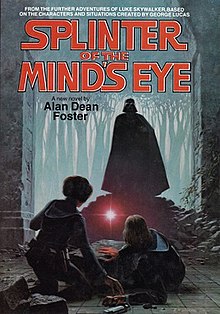Splinter of the Mind's Eye
This article has multiple issues. Please help improve it or discuss these issues on the talk page. (Learn how and when to remove these template messages)
|
 | |
| Author | Alan Dean Foster |
|---|---|
| Country | United States |
| Language | English |
| Series | Star Wars |
| Genre | Science fiction |
| Publisher | Del Rey Books |
Publication date | Hardcover: March 1, 1978 Paperback: April 1, 1978 |
| Media type | Print (Hardcover & Paperback) |
| Pages | Hardcover: 216 Paperback: 199 |
| ISBN | 0-345-27566-7 |
| Preceded by | From the Adventures of Luke Skywalker (1976) |
| Followed by | Star Wars Episode V: The Empire Strikes Back (1980) |
Star Wars: Splinter of the Mind's Eye is a 1978 science fiction novel written by Alan Dean Foster. It takes place between A New Hope and its sequel The Empire Strikes Back. Originally published in 1978 by Del Rey, a division of Ballantine Books, it was the first original full-length Star Wars novel to be published after the release of the original Star Wars film, retroactively making it one of the earliest Star Wars expanded universe works.
The novel's principal characters are Luke Skywalker, Princess Leia, C-3PO, R2-D2, and Darth Vader. The characters of Han Solo and Chewbacca do not appear, and Solo is only referred to by Luke Skywalker as "a pirate and a smuggler" that he knows at the end of the book. The book was originally written to be filmed as a low-budget sequel to Star Wars if the original film was not a success.[1]
History
In 1976, Alan Dean Foster was contracted to ghostwrite a novelization for Star Wars. Foster was given extensive access to the shooting and draft scripts, as well as early story treatments, for use as source material in fleshing out the novel. Elements of this are visible in the resulting novel, such as the prologue, which borrows the Journal of the Whills title from Lucas's original synopsis.
Foster's contract also required a second novel, to be used as a basis for a low-budget sequel to Star Wars in case the film was not successful. Though Foster was granted a great deal of leeway in developing the story, a key requirement was that many of the props from the previous production could be reused when shooting the new film. Foster's decision to place his story on a misty jungle planet was also intended to reduce set and background costs for a film adaptation. According to Foster, Lucas's only request upon inspecting the manuscript was the removal of a space dogfight undertaken by Luke and Leia before crash-landing on Mimban, which would have been effects-heavy and expensive to film.
The eponymous "Mind's Eye" of the story is a MacGuffin called the Kaiburr crystal. This was based on the "Kiber" crystal, a Force-amplifying talisman that was included in early drafts of the Star Wars story, but later eliminated by Lucas in favor of making the Force a more ethereal power.
By the time the novel was published, Star Wars had broken records in box office receipts, and the film adaptation of Splinter of the Mind's Eye was abandoned in favor of Lucas' vision of a big budget sequel.[1]
The book was later adapted as a graphic novel by Terry Austin and Chris Sprouse and published by Dark Horse Comics in 1996. It incorporated characters from The Empire Strikes Back who did not appear in the original novel.
The Los Angeles Times listed Splinter of the Mind's Eye as one of the most influential works of the Star Wars expanded universe.[2]
ISBN Information
- Splinter of the Mind's Eye, First Ed, Paperback, 1978. Alan Dean Foster, ISBN 0-345-32023-9
- Splinter of the Mind's Eye, First Ed, Hardback, 1978. Alan Dean Foster, ISBN 0-345-27566-7
- Splinter of the Mind's Eye, Book Club Ed, Hardback, 1978. Alan Dean Foster, Book Club # 2597
References
- ^ a b Fry, Jason (July–August 2000). "Alan Dean Foster: Author of the Mind's Eye". Star Wars Insider (50).
- ^ Patrick Kevin Day; Geoff Boucher (2008). "Star Wars' expanded universe". Los Angeles Times. p. 9 of 10. Retrieved May 7, 2008.
External links
- Splinter of the Mind's Eye on Wookieepedia, a Star Wars wiki
